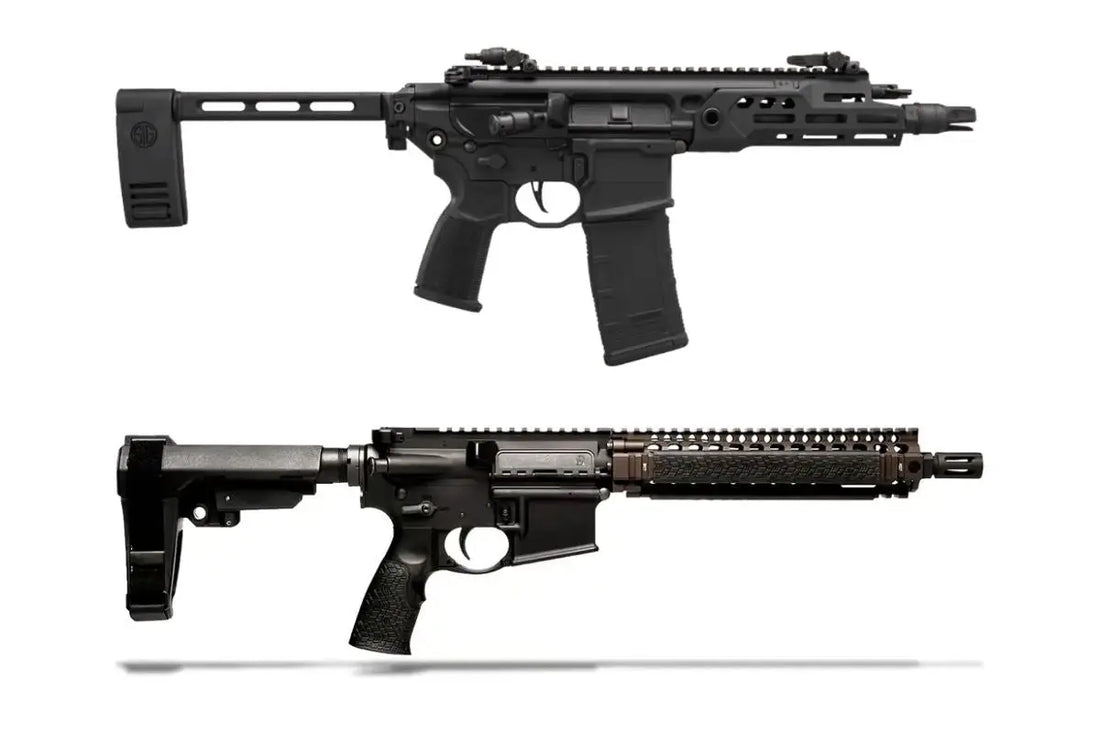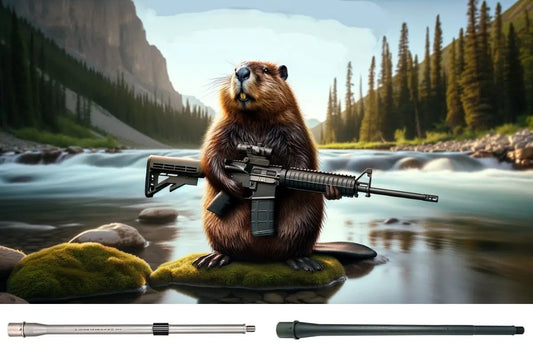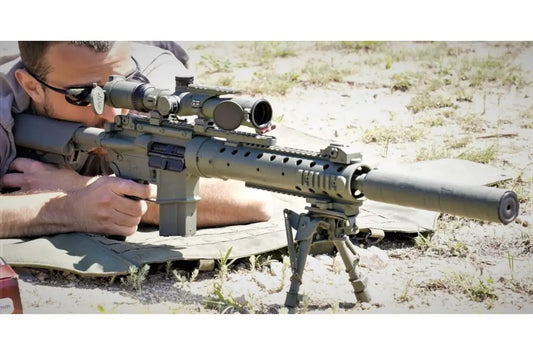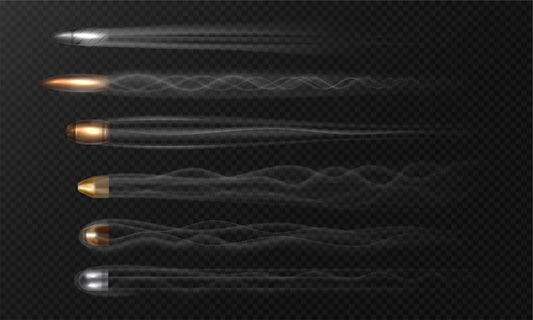
Beyond 16 Inches: The Definitive 2025 Guide to Short-Barreled Rifles (SBRs)
Fast-Reference Cheat Sheet: “Is My Rifle an SBR?”
|
Topic |
Key Numbers & Tests |
Why It Matters |
|
Barrel-length threshold |
Under 16 inches (measured breech face ➜ muzzle, crown to closed bolt) |
Falls under National Firearms Act (NFA) regulation |
|
Overall-length (OAL) safety net |
Under 26 inches with stock fully extended |
A folding-stock 18″ carbine can still be an SBR if the folder keeps OAL < 26″ |
|
Tax stamp |
$200 (Form 1 DIY build / Form 4 dealer transfer) |
One-time payment; attaches to the serialized receiver forever |
|
Registration queue (2025 averages) |
e-Form 1: 28-65 days |
|
|
Form 4: 205-260 days (fingerprint-card bottleneck) |
Knowing wait times lets you plan parts purchases |
|
|
Typical velocity loss vs. 16″ 5.56 |
−120–150 fps per inch from 14.5″→10.3″ |
Translates to ~25 % less energy and shorter fragmentation range |
|
Notable factory SBRs |
Daniel Defense MK18 10.3″ • SIG MCX Rattler 5.5″ • LWRC IC-PSD 8.5″ |
Purpose-built; no home-brew headaches |
|
Major litigation wildcards |
2023 ATF brace rule on life-support after two appellate smack-downs (5th & 8th Circuits, 2024) |
Outcome could reshape “brace-equals-SBR” landscape |
Few three-letter acronyms spark as much debate on the range or in the comment section as SBR. Below we slice through the legal jargon, chronograph data, and industry myth to answer one deceptively simple question: “What actually constitutes a short-barreled rifle in the United States—right now, today?”
1. The Legal DNA of an SBR
Under the National Firearms Act of 1934 (NFA) a rifle becomes an SBR when either of two tests is failed:
- Barrel < 16 inches (rifled bore)
- Overall length < 26 inches (stock unfolded / extended)
ATF inspectors measure from the closed bolt face to the permanent muzzle end. A pinned-and-welded flash hider counts only if the attachment is “permanent” (blind pin, weld, 1100 °F silver solder). Anything less leaves you holding an NFA item.
Larry Vickers, retired Delta operator and armorer, offers elegant advice:
“Educate yourself before you chop. A piston gun can save headaches on ultra-short barrels, whereas direct-impingement might run like a sewing machine at 14.5 + inches but stumble at 10.”
Common “Gotchas”
- Muzzle devices that are screwed on rather than pinned keep the legal barrel length at the shoulder, not the device’s tip.
- Folding stocks: ATF measures with stock fully deployed, but a side-folder AK with stock folded still flunks the 26″ test.
- PDW braces: After the 2023 rule, a brace evaluated as “shoulderable” converts the pistol into an SBR; litigation is ongoing but do not bank your freedom on internet rumors.
2. Paperwork, Cash, and Calendars
Two Paths
- Form 4 Transfer (buy complete SBR from dealer)
- $200 stamp, CLEO notification, fingerprints, passport photos
- Dealer holds the gun until approval—currently ~7–9 months.
- $200 stamp, e-Forms platform
- Can file as an individual or NFA trust.
- Typical 28–65 days thanks to digital fingerprints.
|
Step |
Cost |
Pain Level |
|
Fingerprint cards |
$20-30 |
Smudgy |
|
Trust (optional) |
$0 (DIY) – $200 (attorney template) |
Future-proof for heirs |
|
ATF tax |
$200 |
Inevitable |
|
Engraving (Form 1) |
$50-80 |
Choose tasteful font |
Pro tip: Submit paperwork before you order exotic parts. Nothing stings like a $2,000 upper collecting dust for eight months.
3. Performance Realities: Ballistics in the Short Lane
5.56 × 45 mm NATO
A 16″ barrel pushes 55-gr M193 to ~3,220 fps. Chop to 10.3″ (DD MK18) and you’re flirting with ~2,530 fps—a ~22 % velocity loss translating to a fragmentation envelope that shrinks from ~150 yd to ~60 yd.
.300 AAC Blackout
.300 BLK was designed for pressure-efficient burn in 9″–10″ tubes and bleeds only ~25 fps per inch beyond that. Even the SIG MCX Rattler’s 5.5″ barrel retains ~1,950 fps with 110-gr supersonic loads—still trucking 800 ft-lbs at CQB distances.
Take-home: If you demand fragmentation or barrier-blind performance at 200 yd+, stay ≥ 11.5″ in 5.56 or jump to .300 BLK.
Pros & Cons of Going Short
- Pros:
- Lightning fast presentation from vehicles and hallways
- Higher probability of retention in gun-grab scenarios
- Excellent suppressor host (less added length)
- Cons:
- Louder, flashier, harsher recoil impulse
- Lower velocity, reduced lethality envelope
- NFA bureaucracy + interstate travel headaches
4. Flagship Factory SBRs Worth Your $200 Stamp
Below are no-compromise rifles—think Swiss-watch metallurgy and obsessive QC.
4.1 Daniel Defense MK18 (10.3″, 5.56 NATO)
The CQB gold standard since SEAL Team Six’s Block II program.
- Specs: 10.3″ CHF barrel, carbine gas, 1:7 twist
- Pros: Bomb-proof reliability, insane parts support, holds 1± MOA with Mk262.
- Cons: Direct-impingement + 10.3″ = over-gassed; virtually demands a suppressor and adjustable block.
- Street Price: ~$1,950 upper / ~$2,400 complete.
- Shop: Daniel Defense MK18
4.2 SIG Sauer MCX Rattler (5.5″, .300 BLK or 5.56)
Chosen by SOCOM’s PDW program for “maximum agility in confined spaces.”
- Specs: 5.5″ or 6.75″ barrel, short-stroke piston, fully folding stock.
- Pros: Runs suppressed right out of the box; caliber-agnostic upper swaps.
- Cons: Pricey magazines, proprietary everything, ear-splitting muzzle blast on 5.56.
- Quote: “The Rattler had one job—fit in a pilot’s seat without compromising fight-out firepower, and it does.” —Mike Joslin, SIG rifle PM
- Street Price: ~$2,400-2,600.
- Shop: SIG MCX Rattler SBR
4.3 LWRC IC-PSD (8.5″, 5.56 NATO)
The thinking-man’s piston SBR; the entire upper is monoforged for strength.
- Specs: 8.5″ NiCorr-treated CHF barrel; short-stroke piston.
- Pros: Sub-26″ OAL with stock collapsed; fighter-jet fast cyclic rate yet soft recoil.
- Cons: Proprietary parts, requires tuned buffer weights for suppressor use.
- Street Price: ~$2,400.
- Shop: LWRC IC-PSD SBR
4.4 Knights Armament KS-1 (11.5″, 5.56 NATO) – Honorable Mention
Latest KAC mil-contract carbine; commercial SBR lowers began shipping Q2 2025. Expect top-tier ambi controls, E3 bolt, and the smoothest recoil in DI land. Street price: if you have to ask…
5. Accessories That Actually Make Sense
- Suppressor: SureFire SOCOM556-Mini2 shrinks to 5″ yet cuts dB almost 30 % vs. flash hider alone. Pinned, it can push a 14.5″ barrel past the 16″ mark for a non-NFA rifle—creative loophole.
- Optic: Reflex plus 3× magnifier dominates, but many professionals now run the EOTech EXPS3 + G45 5× to claw back mid-range precision lost to short tubes.
- Gas tuning: If you insist on 10.3″ DI, an OniX adjustable gas block or H-buffer stack is non-negotiable.
6. Navigating 2025’s Legal Chessboard
Two appellate courts have ruled the brace rule likely unlawful, and insiders expect the DOJ to drop its defense post-2024 election. Speculation flag 🔮: If the rule dies, millions of “pistols” revert overnight, crushing secondary-market SBR premiums. Plan your tax stamps accordingly.
7. Future Trends & Contrarian Ideas
- Caliber shift: Expect 6 mm AR-derived wildcats optimized for 11-13″ barrels, chasing barrier penetration at 500 yd without 5.56’s blast.
- Integrated suppressors: The Sig SLX line hints at factory-pinned mono-can uppers that exceed 16″ OAL, ducking NFA entirely—watch that space.
- e-Stamp 2.0: ATF previewed instant digital approvals at SHOT Show 2025. Skepticism is healthy, but the pilot program is issuing sandbox approvals in under 72 hours.
8. TL;DR for Skimmers
- Any rifle < 16″ barrel OR < 26″ overall = SBR under NFA.
- Requires $200 stamp, registration, background check.
- Daniel Defense MK18, SIG MCX Rattler, and LWRC IC-PSD are benchmark factory options.
- 5.56 loses punch rapidly below 11.5″; .300 BLK thrives in short tubes.
- ATF brace rule may collapse soon—keep one eye on the courts.




